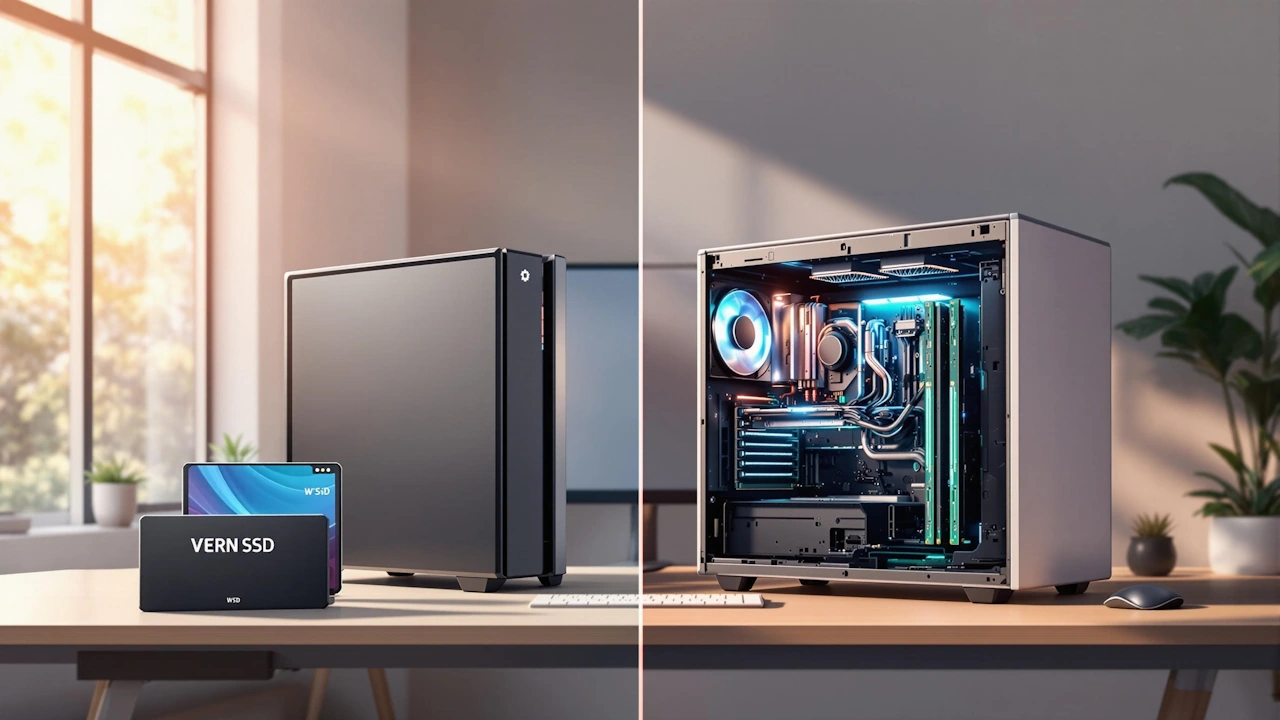Upgrade Solutions
RAM vs SSD: Which Upgrade Boosts Performance More?
RAM vs SSD: Which Upgrade Boosts Performance More?
Upgrading your computer? Here’s the quick answer: Choose an SSD for faster boot times and system responsiveness. Opt for more RAM if you need smoother multitasking or handle memory-heavy tasks. Both upgrades can significantly improve performance, but their impact depends on your current setup and usage.
Key Takeaways:
-
SSD Benefits:
- Cuts boot times by up to 70%.
- Speeds up file access and application launches.
- Ideal for reducing lag in older systems still using HDDs.
-
RAM Benefits:
- Enhances multitasking and program performance.
- Crucial for tasks like video editing, gaming, and content creation.
- Prevents slowdowns caused by insufficient memory.
Quick Comparison:
| Upgrade Type | Best For | Impact |
|---|---|---|
| SSD | Faster boot and load times | Major speed boost for overall responsiveness |
| RAM | Multitasking and heavy programs | Improves performance during active tasks |
| Both | Balanced performance | Resolves storage and memory bottlenecks |
For the best results, start with an SSD if you’re using an HDD. Add more RAM if you already have an SSD but multitasking feels slow. Both upgrades together can transform your system.
RAM and SSD Core Functions
RAM Explained
RAM serves as a high-speed workspace for your computer, temporarily storing active data and running programs. With DDR5-RAM capable of transferring data at speeds up to 51.2 GB/s [4], it ensures smooth multitasking and quick system responses.
Think of RAM like your computer’s desk space – the more you have, the more tasks you can manage at once. If RAM runs out, your system turns to virtual memory on your storage drive, which is much slower and can cause noticeable lag [3].
Here’s how RAM affects various tasks:
| Task Type | RAM Role | Performance Impact |
|---|---|---|
| Everyday Computing | Runs the OS and simple programs | Fast response times |
| Heavy Multitasking | Keeps multiple apps running simultaneously | Prevents slowdowns |
| Content Creation | Handles large files in memory | Speeds up rendering |
| Gaming | Loads game assets and textures | Smoother gameplay |
While RAM handles temporary data, SSDs provide fast, permanent storage for your files and applications.
SSD Explained
SSDs rely on flash memory instead of mechanical parts, offering consistently fast data access. Standard SATA SSDs deliver speeds of about 500 MB/s, while NVMe SSDs push that to 3,000–3,500 MB/s. For example, copying a 20GB file takes under 10 seconds on an NVMe SSD, compared to over two minutes on a traditional HDD [5].
Here’s a comparison of SSD and HDD performance:
| Operation | SSD Performance | HDD Performance |
|---|---|---|
| Chrome Launch | Instant | 15 seconds |
| GTA V Loading | 25 seconds | 120+ seconds |
| Read Speed | 3238.4 MB/s | 57.01 MB/s |
| Write Speed | 2248.9 MB/s | 30.87 MB/s |
While SSDs cost more – averaging £120 per 1TB compared to £60 per 1TB for HDDs [5] – their speed and efficiency make them a smart choice for systems that demand quick data access.
Should you upgrade RAM or SSD first? Which would give better performance?
Speed Tests: RAM vs SSD
Performance tests highlight distinct benefits: upgrading RAM improves processing for demanding tasks, while SSDs make systems more responsive overall.
RAM Upgrade Results
Tests with resource-heavy applications show noticeable improvements after adding RAM. For instance, in Lightroom, applying presets became 2–3× faster, generating smart previews for 100 images dropped from 51 to 21 seconds, and exporting wedding photos took 20 minutes less [7].
RAM is incredibly fast – about 10 times quicker than SSDs and 50 times faster than traditional hard drives (HDDs) [8]. For video editing, the amount of RAM you have makes a big difference:
| Video Project Type | Recommended RAM | Performance Impact |
|---|---|---|
| 1080p or less | 8GB | Standard performance |
| 1080p–4K 8bit | 16GB | Smoother timeline navigation |
| 4K+ Complex | 32GB | Faster rendering |
| 8K 10bit+ | 64GB | Best performance |
RAM upgrades shine when it comes to active processing tasks. However, SSD upgrades tackle a different area – storage efficiency.
SSD Upgrade Results
SSDs deliver a big boost in system responsiveness. For example, desktop boot times dropped from 63 to 23 seconds, and a MacBook Pro saw a 55% jump in SpeedMark performance [2].
When it comes to data transfer speeds, SSDs leave HDDs in the dust:
- HDDs: Around 200 MB/s for reading and writing
- SSDs: Up to 550 MB/s read and 520 MB/s write [9]
Server tests reveal SSDs handle input/output (I/O) requests 20 times faster than HDDs. Under heavy workloads, HDDs process only about 5% of the data that SSDs can manage [6].
Performance Comparison Chart
Here’s a direct comparison of how each upgrade affects system operations:
| Operation Type | RAM Upgrade Impact | SSD Upgrade Impact |
|---|---|---|
| System Boot | Small improvement (5–10%) | Major reduction in time (60–70% faster) |
| File Operations | Minimal change | About 30% faster file opening [6] |
| Photo Editing | 2–3× faster processing | Quicker file access |
| Video Rendering | Faster rendering and processing | Faster file access and export |
| Gaming | Better FPS, reduced lag | Shorter load times |
| Server Reboot | Little impact | Up to 66% faster (10–13s vs 30–40s) [6] |
"Generally, the more RAM your computer has, the larger the digital countertop you have to work on and the faster your programs run" [1].
These findings help clarify which upgrade – RAM or SSD – might better suit your specific needs.
sbb-itb-3b11325
Choosing Between RAM and SSD
Deciding whether to upgrade your RAM or switch to an SSD depends on your system’s specific needs. Here’s how to figure out what will give you the best performance boost.
When to Upgrade Your RAM
If you notice any of these issues, it might be time for more RAM:
| Symptom | What It Means | Effect on System |
|---|---|---|
| System slows down during multitasking | Your computer struggles to handle multiple programs at once | Lower productivity |
| Excessive disk activity | System relies on virtual memory too often | Slower overall performance |
| Gaming stutters | Games freeze temporarily despite a good GPU | Choppy gameplay |
| Crashes in memory-heavy apps | Programs close unexpectedly | Interruptions in your work |
Recommended RAM configurations:
- Basic users (browsing, office tasks): 8GB
- Content creators: 16GB
- Heavy multitaskers: 32GB
- Professional video editors (4K+): 64GB
When to Upgrade to an SSD
Here are the signs that an SSD could be the game-changer you need:
| Problem | How SSD Helps | Result |
|---|---|---|
| Long startup times | Faster boot speeds | Instant system readiness |
| Slow application launches | Quick program access | Smoother workflow |
| System lags during file transfers | Faster data movement | Better efficiency |
| Disk bottlenecks | Improved input/output performance | Consistent speed |
Why Not Both?
Upgrading both RAM and SSD can transform your system, tackling both processing and storage limitations. This approach ensures balanced performance without overspending.
Typical upgrade costs:
- 8GB RAM: £30–45
- 16GB RAM: £60–90
- 500GB SSD: £45–65
- 1TB SSD: £80–120
RAM upgrades can last 8–10 years, while SSDs provide immediate speed improvements, especially for systems still using hard drives. To maximize your investment, identify your system’s biggest bottleneck and address that first.
"Generally, the more RAM your computer has, the larger the digital countertop you have to work on and the faster your programs run" [1].
Getting Professional Help
Upgrading your RAM or SSD can significantly improve your system’s performance, but having a professional handle the installation can save you time and ensure everything is done correctly.
When to Consider Professional Help
Sometimes, it’s best to leave upgrades to the experts. Here are some scenarios where professional help is a smart choice:
| Situation | Why It Matters | What You Gain |
|---|---|---|
| Unsure about compatibility | Professionals use tools like the Crucial Upgrade Selector to confirm compatibility | Confidence in your components |
| Lack of technical experience | Experts handle installation and data migration seamlessly | Avoid accidental damage |
| Older or refurbished systems | Technicians can solve unique compatibility issues | Maximum performance potential |
| Planning multiple upgrades | A full system assessment ensures balanced upgrades | Improved overall performance |
Professionals can do more than just install your components. They offer a range of services, including:
- System diagnostics to pinpoint performance issues
- Component selection to ensure compatibility
- Professional installation for proper setup
- Data migration to transfer files to new SSDs
- System optimization like BIOS and driver configuration
Classic Shop – ITZONE Online

For dependable upgrade services, Classic Shop – ITZONE Online is a great option. Here’s a breakdown of what they offer:
| Service | Price | Includes |
|---|---|---|
| RAM Installation | £29.99 | Compatibility check, installation, and system testing |
| SSD Installation | £99.99 | Drive cloning, data migration, and performance tuning |
| System Diagnosis | Free | Performance check and upgrade suggestions |
Choosing professional installation can help you avoid costly errors and ensure your system runs at its best. Technicians often include extras like internal cleaning and system testing to get the most out of your upgrade.
For older or refurbished computers, their expertise is especially useful. They can identify the maximum RAM your system supports and find the best SSD options for your specific model. This ensures every component is configured correctly for peak performance.
A few tips to keep in mind:
- Always back up your data before any upgrade.
- Ask about warranties and post-installation support.
- Look for bundled services if upgrading both RAM and SSD.
With professional help, you can be confident that your system upgrades will deliver the performance boost you’re looking for.
Conclusion
When deciding on an upgrade, focus on your system’s weakest point. Here’s a quick comparison to guide you:
| Upgrade Type | Best For | Impact |
|---|---|---|
| RAM Upgrade | Multitasking and heavy applications | Boosts performance for active tasks |
| SSD Upgrade | Faster system responsiveness | Quicker boot and load times than HDDs |
| Combined Upgrade | Overall system performance | Resolves both memory and storage issues |
Use this as your rule of thumb:
- Go for an SSD if you’re still using an HDD. This will drastically improve boot times and overall responsiveness.
- Upgrade RAM if you already have an SSD but need smoother multitasking.
- Add more memory if your current RAM usage maxes out during intensive tasks.
"RAM upgrades are more about allowing more space for the software and operating systems to run effectively. However, upgrading the storage eliminates the storage bottlenecks which cause slow booting, and longer software loading times" [10].
For the best results, start with an NVMe SSD if your system supports it. Then, increase your RAM capacity and speed. This approach ensures a well-rounded performance boost based on the metrics discussed earlier.

